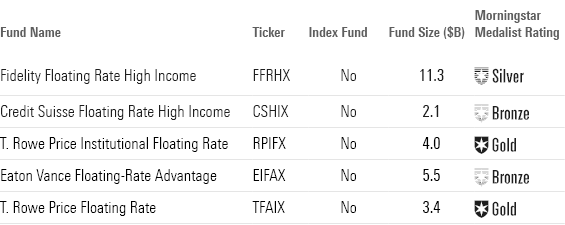5 Top-Performing Bank-Loan Funds
Funds from T. Rowe Price, Fidelity, and Eaton Vance are among those with the best track records.

Amid the carnage of last year’s big bear market for bonds, one mutual fund category lived up to its reputation as a safe haven during times of rising interest rates: bank-loan funds.
Bank-loan funds invest in lower-quality debt that comes with floating rate features, which can help investors cushion a bond portfolio against the negative impact of rising interest rates. When interest rates rise, bond prices fall, but floating rates mean these bonds pay out higher yields as short-term rates rise, and as a result, they don’t typically see their prices fall as regular bonds do. However, their prices can be sensitive to credit market conditions, as well as their issuers’ perceived ability to pay back debt.
Now, with the Federal Reserve widely believed to be near or at the end of its interest-rate increases for this economic cycle, investors can look at the top performers from the last one-, three- and five-year time frames for funds that can offer top returns in both sharply rising and low-rate environments.
In this category, the best performers have been actively managed funds, not index funds, and sector and security selection have often been key determinants for returns. Among the top performers are funds from T. Rowe Price, Credit Suisse, Eaton Vance, and Fidelity Investments.
Bank-Loan Fund Performance
In 2022, as the Fed raised rates to combat inflation, bond prices fell sharply across much of the market, losing 13% as measured by the Morningstar US Core Bond Index. However, the average bank-loan fund lost only 2.5%, with many top-performing managers shifting to greater holdings among defensive industries in the last quarter of 2022.
This year so far, the category has continued to outperform, gaining 7.1%, while the Core Bond Index has returned only 1.6%. Over a 12-month trailing period ending Aug. 9, the average bank-loan fund has returned 7.1% while the overall bond market has lost 2.9%
Bank-Loan Funds vs. the US Core Bond market
What Are Bank-Loan Funds?
These portfolios primarily invest in floating-rate bank loans and floating-rate below-investment-grade securities instead of bonds. Because of those below-investment-grade investments, the primary risk associated with these funds is the risk of default. In exchange for this credit risk, these loans offer high-interest payments that typically float above common short-term benchmarks.
Top-Performing Bank-Loan Funds
To screen for the best-performing funds in this Morningstar Category, we looked for the strategies that have posted top returns across multiple time periods.
We first screened for funds that ranked in the top 25% of the category using their lowest-cost share classes over the past one-, three-, and five-year time frames. In addition, we screened for funds with Morningstar Medalist Ratings of Gold, Silver, or Bronze for those classes. We also excluded funds with less than $100 million in assets and those with minimal or no Morningstar analyst input on their Medalist Ratings.
From this screen, we’ve highlighted the five funds with the best year-to-date performance. This group consists only of actively managed funds.
Because the screen was created with the lowest-cost share class for each fund, some funds may be listed with share classes that are not accessible to individual investors outside of retirement plans. The individual investor versions of those funds may carry higher fees, which reduces returns to shareholders.
Top-Performing Bank-Loan Funds

Fidelity Advisor Floating Rate High Income Fund
- Ticker: FFRHX
- Morningstar Medalist Rating: Silver
- Morningstar Rating: 5 stars
“Under former lead Christine McConnell, this strategy was largely resilient during periods of market stress, such as the 2008 global financial crisis, though it too lagged the vast majority of its peers in the healthier bank-loan markets of 2009, 2010, and 2012. By contrast, current lead manager Eric Mollenhauer’s modestly less cautious approach helped it land in the best half of the category during risk-rewarding periods such as 2016 and 2019.
“In 2021′s favorable environment for bank loans, the strategy gained 5.6% for the year, besting over four-fifths of a distinct group of category peers in the process, thanks largely to its oil and gas positioning. As rates spiked and credit tumbled in 2022, the managers’ selections and underweighting in loans that were rated CCC and below helped limit the strategy’s loss to 0.3%, which was less severe than that of over 90% of peers.”
—Sam Kulahan, senior analyst
Credit Suisse Floating Rate High Income
- Ticker: CSHIX
- Morningstar Medalist Rating: Bronze
- Morningstar Rating: 5 stars
“The approach here combines fundamental analysis with a top-down macroeconomic overlay. However, the strategy’s access to deals and the team’s ability to implement tactical shifts and make sound decisions in the riskier part of the market distinguish it from most. For example, the team’s decision to downplay cyclical loans because of valuation concerns at the end of 2019 and the addition of hard-hit companies as markets stabilized following the March 2020 COVID-19-driven sell-off prevented deeper losses in the downturn and set up a swift gain later that year.
“In line with the team’s view of moving out of cyclical industries toward more defensive sectors, healthcare (13%), financials (12%), and technology (17%) made up the three largest sector exposures in September 2022. The team believes these sectors are highly diversified and act as insulation against rising inflation risk in the market.
“The team’s value-oriented approach has contributed to its standout record, but the strategy doesn’t shy away from risks, which can hurt during bouts of credit stress. That said, the team’s stringent security selection and smart calls have helped the strategy navigate market downturns.”
—Saraja Samant, analyst
T. Rowe Price Institutional Floating Rate
- Ticker: RPIFX
- Morningstar Medalist Rating: Gold
- Morningstar Rating: 5 stars
“The strategy boasts an enviable long-term record. Since manager Paul Massaro took the reins in January 2013, the institutional shares’ 3.8% annualized gain through January 2023 beat its median peer’s 3.3%, landing the strategy in the top decile of rivals. Moreover, the fund’s volatility-adjusted performance is even better; its Sharpe ratio (a measure of return relative to standard deviation) was the best in the category over the same period. The calendar year 2022′s 0.6% loss demonstrated the fund’s defensive approach, as it was less severe than its typical rival’s 2.0% drop.
“The core portfolio focuses on bank loans of issuers rated BB or B, which offer better value than lower-rated names. However, this team will opportunistically delve into CCC-rated paper when valuations and structures are attractive. For example, its stake in loans rated CCC and below rose to 11.1% of its assets as of December 2022 from 6.3% three years prior—9.3 percentage points of which represents second-lien loans with strong covenant packages.”
—Paul Olmsted, senior analyst
Eaton Vance Floating-Rate Advantage
- Ticker: EIFAX
- Morningstar Medalist Rating: Bronze
- Morningstar Rating: 4 Stars
“This fund’s category-best 3.7% annualized gain over the trailing ten years ended May 2023 outpaced its median category peer’s 3.1%. Volatility-adjusted performance, as measured by its Sharpe ratio, landed ahead of 70% of peers over the same period. Along with its added leverage, annualized performance over the past three- and five-year periods kept this fund among the best.
“While the team’s preference for larger, more liquid issuers and its focus on issuers rated BB and B has helped it over full credit cycles, its use of leverage has led to greater up-capture and larger drawdowns than its peers.
“Software stands out as the fund’s largest overweight (15.9% versus the market’s 11.7%). The team believes the market mis-rates this sector, especially software-as-a-service companies. Allocations to healthcare (5.2%), diversified telecommunications (4.8%), machinery (4.3%), and hotels, restaurants, and leisure (4.3%) round out the strategy’s largest exposures as of March 2023.”
—Paul Olmsted
T. Rowe Price Floating Rate
- Ticker: TFAIX
- Morningstar Medalist Rating: Gold
- Morningstar Rating: 5 stars
“The institutional shares’ 3.5% annualized gain through January 2023 outpaced its median peer’s 3.3%, landing it near the top third of the category. Investors were amply rewarded for the fund’s risk, and its returns look even better when adjusted for volatility. The fund’s Sharpe ratio was among its peers’ top quintile over the same period.”
“Consistency has been a hallmark here, a result of diligent security selection, low historical defaults, and effective risk management. This team relies on its ability to avoid the riskiest issuers and structures, typically favoring loans rated BB and B, while it’s selective for loans rated CCC and below to help dampen volatility. As a result, the strategy tends to look median-like during rebound periods, but it has suffered less than most peers in market selloffs. During calendar 2022, which was marked by heightened volatility and rising yields, this fund’s 0.6% loss was less severe than its typical peer’s 2.0% drop. Strong relative sector allocation and security selection in information technology, financials, and healthcare drove this result.”
—Paul Olmsted
Long-Term Returns of Top-Performing Bank-Loan Funds

The author or authors do not own shares in any securities mentioned in this article. Find out about Morningstar’s editorial policies.

/s3.amazonaws.com/arc-authors/morningstar/4513c31c-df10-4538-9285-4707e579cd32.jpg)
/cloudfront-us-east-1.images.arcpublishing.com/morningstar/CGEMAKSOGVCKBCSH32YM7X5FWI.png)
/cloudfront-us-east-1.images.arcpublishing.com/morningstar/BAG2H5VQKBERZKT5SM7JTWM6CY.jpg)
/d10o6nnig0wrdw.cloudfront.net/04-29-2024/t_eae1cd6b656f43d5bf31399c8d7310a7_name_file_960x540_1600_v4_.jpg)
:quality(80)/s3.amazonaws.com/arc-authors/morningstar/4513c31c-df10-4538-9285-4707e579cd32.jpg)